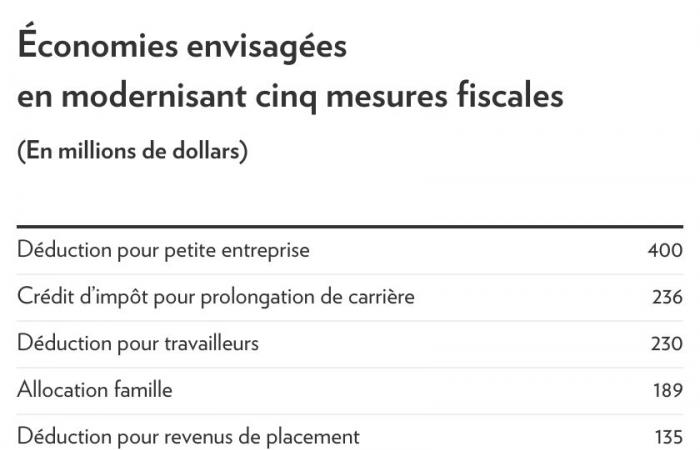As you know, the Quebec government is eagerly seeking to erase its $11 billion deficit. He has also imposed a hiring freeze and is scrutinizing any new budgetary expenditure.
Posted at 6:30 a.m.
To get out of this situation, the Minister of Finance, Eric Girard, has also clearly indicated his intention to fish in a fertile lake, that of tax measures.
However, the minister would be able to raise 1.2 billion without too much pain by modernizing five tax measures and expenditures, according to an analysis by the Research Chair in Taxation and Public Finance at the University of Sherbrooke (CFFP).
The beauty of cleaning up tax expenditures is that it does not involve layoffs in the government apparatus (public service, health, education), as is the case with budget cuts. However, it affects the wallets of certain taxpayers, individuals and businesses, often the wealthiest.
In total, the Quebec government has an arsenal of 312 tax expenditures for a sum of 74 billion (in comparison, budgetary expenditures are some 136 billion).
That said, be careful, many of these measures are very relevant and their existence is not called into question, whether we think of the basic personal allowance granted to all taxpayers on their taxes (14.7 billion), deductions for RRSPs and pension plans ($14.2 billion), recently revised measures ($6.9 billion) and a series of others.
At the end of the day, there remain around a hundred tax expenditures totaling 15.2 billion which deserve to be optimized or completely eliminated, estimate the CFFP researchers, composed in particular of Luc Godbout, Suzy St-Cerny and Michaël Robert-Angers.
And according to their impressive work, the Quebec government could save nearly $1.2 billion by targeting just five measures.
Some will say that it is little, 1.2 billion, out of a deficit of 11 billion. This forgets that part of the deficit will be reduced with economic growth and that the structural deficit that really needs to be reduced is around 5 billion.
Credit for older workers
First target, therefore: the tax credit for career extension, which costs 400 million. This credit paid to workers aged 60 and over has existed for several years, but its effectiveness is contested1.
Above all, the average retirement age in Quebec has increased significantly over the past decade, going from 61.5 years to 64.7 years, almost reaching the Canadian average (65.1 years).
The researchers would not eliminate the credit, given the crucial importance of the work of older people in the context of the aging population. They would instead increase eligibility to 65 and over, instead of 60, improve it and refocus it towards the middle class ($80,000 maximum income to benefit from it).
In short, a worker aged 66, say, who would receive $50,000 of taxable income, including $20,000 for his work, would save $1,750 in taxes with the suggestion, rather than $1,540. Those under 65 would lose the advantage.
Net economy: 236 million.
My antennae tell me that this will be discussed in the budget update on November 21.
Family allowance
Second proposal: the modernization of the family allowance. Currently, all families receive a minimum allowance, even millionaires. And this allowance is tax-free.
The researchers propose various scenarios, one of which is to eliminate the minimum amount and gradually reduce aid to wealthier families. Assistance would disappear for a couple with two children who earn more than $224,000.
Their change would make winners. Thus, the allowance for a family of two children with income of $90,000 would increase from $4,702 to $4,845 in one of their suggestions, a gain of $143. There would also be gains for a family with $150,000 in income.
To lose out, for example, a family of two children would need an income of $175,000, with the allowance going from $2,326 to $1,896.
Possible savings: 189 million.
Deduction for workers
Third target: the worker deduction. This deduction is intended to compensate for expenses inherent to working (clothing, transportation, etc.). The researchers would transform this deduction into tax credits, as at the federal level.
This change would not or very little affect low and middle incomes, and a little on high incomes (over $98,540). For example, a taxpayer with $120,000 in income would no longer have $318 in savings, on average, but $180, a loss of $137.
Possible savings: 230 million.
Deduction for investment income
Fourth proposal: the transformation of the deduction for investment income. This deduction concerns taxpayers who spend to earn investment income. The researchers would transform this deduction into a tax credit (of 14%).
Once again, it is those with higher incomes who would be more affected. For example, for a taxpayer who earns more than $119,910, the average annual gain would drop from $1,370 to $746.
Savings envisaged for the government: 135 million.
SME tax
Fifth target: the small business deduction or DPE, the bill for which reaches 984 million in 2024. This is the lower tax rate granted to SMEs2criticized by the Organization for Economic Co-operation and Development (OECD) because it would harm productivity.
Currently, the rate is 3.2% for the taxable income bracket below $500,000. The rate jumps suddenly to 11.5% for incomes above $500,000. This sudden change encourages some companies to play tricks to distribute their taxable income between various companies to pay less taxes.
The CFFP suggests lowering the threshold to $200,000 and gradually increasing the rate from 3.2% to 11.5% between $200,000 and $500,000 of taxable income.
Possible saving: 400 million, subject to certain other technical adjustments.
In short, by targeting certain costly tax measures, the government would manage to save 1.2 billion without too much pain. Not so bad, though3…
1. Consult a study on the tax credit for career extension
2. The measure applies to SMEs that have up to 50 million capital, but the SMEs that maximize the effect of the measure are those that have capital of 10 million.
3. The researchers also propose withdrawing a certain advantage from well-off contributors to the Registered Education Savings Plan (savings of 30 million), or even modernizing the advantages linked to workers’ funds (gain of 30 million).







